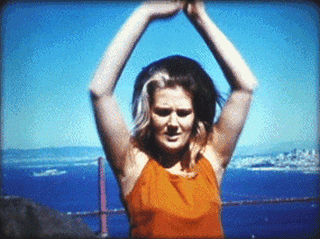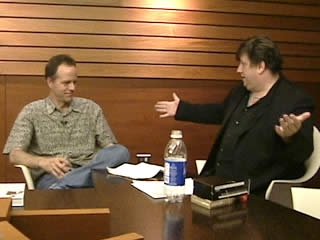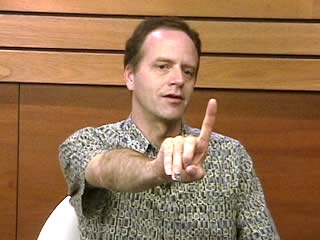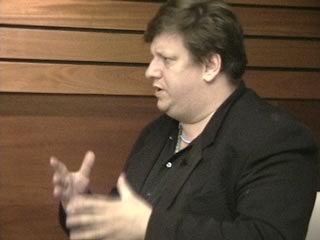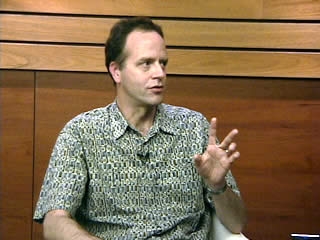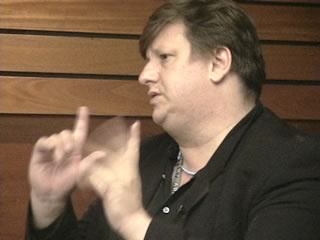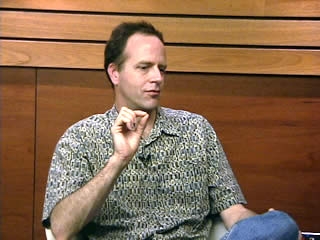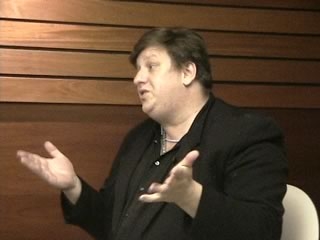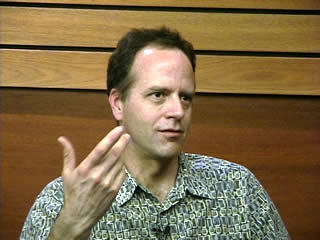Feature: Projects
Scott Stark: Angel Beach
Editor’s note – San Francisco-based avant-garde filmmaker Scott Stark knows how to shake things up. Mining imagery from eclectic and unlikely sources – everything from airplane passenger safety cards and acts of urban sabotage, to the view out his kitchen window – Stark’s methodically crafted works push the boundaries of cinematic convention in search of new layers of meaning. As viewers, our expectations of the filmic experience are intentionally, often aggressively, challenged by Stark’s hypnotic dances of light and sound. Yet Stark’s explorations reach beyond perceptual surfaces to amuse, provoke, mystify, and reveal. A prolific artist, Stark has produced over 60 experimental films and videos since 1980.
Dale Hoyt, a frequent Stretcher contributor, is also a noted Bay Area filmmaker. Hoyt’s videotapes, drawings and paintings are in numerous museum permanent collections including the Museum Of Modern Art in New York City.
Following is a conversation with Scott in which he discusses his work, his techniques, and the inspiration and intent behind films such as “Angel Beach”.
To view “Angel Beach,” adapted for the Web especially for Stretcher, click here >>
– David Lawrence
Dale Hoyt I want to congratulate you on your participation in the Whitney Biennale, and on your film Angel Beach, which is a minor miracle. You’ve created something that people have been trying to do as long as cinema has been around, a 3D film that you don’t have to wear glasses to see. How did you do it?
Scott Stark To me it’s not quite 3D, but it does suggest 3D. What’s interesting is that it’s somewhere in between the 2D and 3D. There’s an interesting tension between the two. A little bit of history about where Angel Beach came from: I was at a flea market about four or five years ago and found a big box of 3D stereoscopic slides that a photographer had taken on Northern California beaches in the late 1960s and early 70s, mostly of young women in bikinis. Some men, too, but mostly women, usually shot without their knowledge, from the hip, it looks like. The slides had these strange camera angles and inadvertent framing that is quite interesting.
The images sat around in a box for a while – I didn’t know quite what to do with them. I eventually came upon the idea of going back and forth between the two images on a single strip of film. So what you’re seeing in the film, on the most fundamental level, is alternating between the left and right frames. You get a flickering effect between the two images. Part of the process is finding the focal point between the two images, because when you’re looking in the world in 3D, your eyes come together on a particular object. If I’m holding my finger out in front of me and looking at my finger, I see one finger, but I see two doors over there. But if I look at the doors, I see two fingers in front of me. That’s the parallax nature of three-dimensional perception. My job was to find interesting places to join a focal point in the two images, where they would become static.
DH You figured out the secret behind any 3D thing, which is that the mind wants to make sense of an image, and when you flicker between two images, you create completely internal 3D effects. It’s a still image, but you’re seeing it in time. It’s an astonishing thing. One of the delights of your work for me is that it manifests the promises made by some of my early teachers and heroes, namely Tony Conrad, Paul Sharits and especially Peter Kubelka. You’ve realized Peter Kubelka’s theory of metric film, which is film editing as a musical composition. There is even a moment in Angel Beach where you conspicuously go from 4/4 rhythm to 3/4 and then to 5/4, and even an unmusical person like me can detect it. Could you talk about the musical structures that you’ve employed in Angel Beach and in the other pieces?
SS It’s interesting that you say that about Angel Beach, because it’s a silent film. You don’t actually hear anything while you’re watching it.
DH Yes, but, there’s that moment where all of a sudden, it’s going from 4/4 to a waltz.
SS Yeah, that’s interesting about silent films. Especially when there are strong visual rhythms I think you do pick up emotionally or mentally a kind of musical sound based on visuals. I’ve worked with that relationship between image and sound a lot in the past. I have a series called The Chromesthetic Response films which use images to generate the sound with 16mm optical sound. The image actually creates the sound because it overlaps onto the soundtrack area. It was interesting to work that way because I was making decisions about sound without being able to hear it. They were purely visual. I also worked a lot, especially in the ‘80s, with Super8 sound cameras and I find that revealing and liberating.
DH That was probably the basis of Don’t Even Think.
SS Don’t Even Think is a good example of that, yes. A lot of my Super8 films, like Don’t Even Think were almost completely shot in camera. I would shoot a location where there was a certain amount of noise, then go to a different location with different noise, then come back to the original location. Each time there’s a start and stop there’s a punctuation, which makes the entire shot like a kind of musical note, and those get strung together as I’m shooting it. It’s an intuitive thing – obviously I can’t hear it while I’m shooting it, but I have a sense of it conceptually. I’m responding to things that are happening around me.
DH Could you talk a little bit about going from film to video? Was that a trauma?
SS No, with everything I’ve worked in, I’ve tried to do something that’s specific to that medium. The thing that’s nice about Super8 is that when you turn the camera on and turn it off, there’s an instantaneity. It stops and starts exactly when you’re doing it, where with video, there’s a little bit of slippage – it takes up a second or two for everything to get up to speed – so when you’re shooting in camera you can work with that kind of punctuation that you can’t get with video. That was revealing and wonderful to me. It’s also something I couldn’t do in 16mm because it’s very expensive and very hard to do. So, my 16mm work tended to be more like Chromesthetic Response, where I was working in a lab situation and playing with the surface of the film in some way. Video has other qualities that are interesting. The sound is a crisper, clearer, and sharper. That opened up possibilities. The fact that you could shoot a lot of stuff cheaply and not worry about changing a cartridge every three minutes seemed like something worth exploring, too. I think the first video that I finished was Unauthorized Access, where I went into the stairwells of high-rise buildings in downtown San Francisco. A lot of them had, not fire alarms, but alarms on the doors that go to the roof, and the idea was to go in there in “Mission Impossible” style, taping the doors shut, taping the locks, so we could back out, set off the alarm, look out the window, run back downstairs, and then edit all those alarms into a piece of music. I couldn’t do that in 16mm or Super8 film.
DH Do you think there’s more of a musical structure to video than film?
SS I’m not sure there’s a more musical structure, but it’s easier to manipulate it. And video tends to be more about editing later rather than the spontaneity of Super8, where it’s more about being in the moment and responding to what I’m seeing, and the film is a reflection of the things that were happening while I was filming. Video is about taking the footage and doing something later with it. When you get into editing it that way, it’s very easy to explore musical structure in video.
DH You’re definitely a structuralist at heart. You’re sort of a neo-structuralist and this brings me to one of my favorite pieces of yours – In.side.out. Describe that piece and what led to it.
SS I starting shooting in 1994 and finished it in 1998 or 1999. I’d just moved into my house, in Bernal Heights in San Francisco, and there was an empty lot next door. On the lot on the other side there was a ramshackle old house that no one had lived in for five years. Both lots had just been sold to a developer. The lot was totally overgrown with rose bushes that were 50 or 100 years old, the house was falling down, and it was quite beautiful open space. You couldn’t even walk through, it was so overgrown, and I knew that at some point these developers were going to come in, dig everything up, get rid of the roses, and tear down the house. So I started documenting every couple of months or so, putting the camera in three locations around my house facing those two lots and doing certain kinds of structured camera movements – panning left and right, panning up and down – studying the space from different angles. Then, as it began to evolve, they started tearing off the outer siding and taking out different things around the house. Other little structures started coming up and then one day they came with a bulldozer and started digging everything up. I kept documenting these transformations as they happened. Later, I edited them into a loose structure, not a real rigid structure like some of my other work, but going back and forth and tying together the changes. It’s not linear, but compares the old and new and the in-between stages of it, and the different kinds of sounds, night scenes and rain scenes, and so on. It explores all the different changes that were happening through time, man-made changes and also just from weather and nature.
DH Especially that wonderful last scene, when the house breaks apart, sort of like a…
SS It’s a personal work, too, because a lot of it is shot from inside my house looking through the window. There’s one scene from inside a bedroom, and out the window you see a bulldozer munching its way up the hill. It’s disturbing to have your house so close to that kind of thing. It’s a metaphor for me in a way, maybe my personal space or my personal sense of self and these are the walls I have around me, but then there is a certain lack of control that I have with what’s happening in the outside world, too. The camera is a go-between, looking out that window and coming back into the house a lot, as well.
DH It seems very personal. Since we’re living in San Francisco, I’m obliged to ask you if somehow that was a story of gentrification.
SS What you see in the video is that it gets replaced with these brand spanking new yuppie scale houses that sold for 1/2 million dollars a piece and now are worth quite a bit more than that. It was definitely taking away something very organic that had a real tactile sense and putting huge buildings up which block the view. There is something gained for the people who are living there and paid a lot of money to live there, but I think a lot was lost in the process. It is a kind a metaphor for gentrification, what we’ve seen happen over the last few years in San Francisco.
DH Plus, you documented the violence of it all. Literally, the house splitting into two, like an egg being opened. It’s one of the most amazing images I’ve seen in a long time. I wanted to talk about another one of my favorite pieces of yours, NOEMA. It’s by no means an erotic work, but…
SS Don’t you think Angel Beach is more erotic?
DH Yes, I would say Angel Beach is by comparison, well, Angel Beach is not erotic, it’s definitely a celebration of bodies, but…
SS Angel Beach, I think one of the things that’s most disturbing about it is when it becomes erotic. People become a little uncomfortable with that. Because the photographer was very voyeuristic with the way he was photographing these women. Nowadays it’s almost politically incorrect to do that sort of thing, but rather than distance myself from what he was doing and comment on it critically, I made the decision to inhabit his eyes and to try to enhance what he was doing in some ways, exploring the fact that this is not only disturbing and maybe wrong, it’s also very pleasurable; and there’s a certain pleasure and desire in looking at these bodies and the way they’re moving. I hope that what I’ve done is show not only the thing he was looking at when he was photographing, but the things that he was missing that were there as well.
DH Exactly. Which is definitely what you were approaching in NOEMA. Could you describe NOEMA?
SS NOEMA is all found commercial pornography taken from VHS copies of tapes you can find in any video store nowadays, except for Blockbuster, I guess. I went through these commercial pornography tapes and took out the moments where very little was happening, usually when people were changing positions or between one position or another.
DH It seems at that very moment where people seem vulnerable.
SS I think of it as the moments between moments. It’s the things that the people who watch those videos don’t remember when they’re thinking about them later. They might even fast forward through those parts. It was the lost moments. Changing positions during lovemaking can be a very erotic moment. But in these videos, it’s usually the director saying “Okay, it’s time to take position number seven instead of position number five.” So, the actors are just shifting and they don’t look like they’re ready to get down to it. They become vulnerable, almost human in those moments, rather than just these grinding machines which they are during most of it. I wanted to capture those and also the moments where the camera person, for some transition or for some little poetic touch, decides to pan up from the action, maybe to the painting on the wall or something like that. You get movements that have nothing to do with the sexual activity, but had some purpose in the original video. My video focuses on those two kinds of movements. It’s structurally edited – each shot is two seconds long and you see the same things loop over and over again. You get to study the very human movements of someone trying to get up off the bed into another position. It becomes very beautiful, I think, like a little ballet.
DH I was about to say it approaches dance, especially when you have those three graces, it actually looks like Matisse’s Dance with Nasturtiums.
SS I also see it as people who are in between where they were and where they want to go. They’re trapped in this movement; they never quite get there. They’re also trapped in this environment with cheesy paintings on the wall, bad carpeting, and bad wallpaper and it’s almost sad and, as you mentioned, humanizing.
DH Having said that, what is your relationship to content? We’ve already talked about the fact that you’ve got two very logical pieces that have lots of wonderful flesh, but it reminds me of a conversation I once had with a teacher of mine, Kathy Acker, who wrote many novels that were drenched in sex and violence, but were also many other things, too. I posed the question to her of what was her relationship with content. And she said, “Well I’m not into content, content means nothing to me. I’m a formalist.” And then I said to her, “Why don’t you do a novel about an orphan and a puppy if content means nothing to you?” I think she slapped me. Could you ruminate on your relationship to content?
SS Tough question. I definitely come out of the structuralist background. I was very influenced by Paul Sharits and Hollis Frampton, and their idea of using a basic formal device to explore something about the world or about the perceptual process that makes us human. Like Kathy Acker said, that’s an interesting thing to explore, but you can’t do that without some kind of content. What becomes interesting to me is when you start looking at content and using formal devices, the other things that can start to come out than those things that were originally intended in the content. As you start scratching the surface with your formal devices, I think you start revealing more things about it. I had an earlier piece where I used some pornography. I thought I didn’t care about the content, I just wanted to explore a particular formal device. Someone asked me “Why did you use pornography there? Why didn’t you just use a computer program, or even a computer?” I thought about that and I realized there was a reason why I was using that content. There was something I wanted to explore about the human condition and about the perceptual processes that are engaged when you start scratching at things using formal devices.
DH And then you also have the building piece that you did…
SS Unauthorized Access.
DH Unauthorized Access. There’s a reductionist term that gets thrown a lot. Have you ever been accused of being a bad boy?
SS I’m not sure what that term means.
DH Bad boy? That somehow you’re violating things in terms of – it’s a stupid question.
SS No, no, I think you’re getting something interesting actually. I just want to make sure I understand.
DH I saw Unauthorized Access shortly after September 11, and you realize that security… you couldn’t make that tape today. Well, you could, but you’d be shot.
SS Or, I would feel very uncomfortable doing it…
DH Have you ever been accused of inciting transgressions? Or inciting uncomfortable reactions?
SS It doesn’t happen often, because I think most people are patient enough or astute enough to see that with a film like NOEMA, I’m not trying to make a porn film. I’m not trying to get people excited. Most people understand what’s going on, even if the imagery disturbs them in some way, maybe they don’t even like it. Like the people who just can’t stand watching pornography, and they have a knee-jerk reaction. That did happen once during the Super8 piece I was talking about, when it was shown at the Cinematheque about six or seven years ago. The imagery is just nebulous red imagery that looks like it might be flesh, but you’re not sure. On the soundtrack, I have a friend reading an excerpt from a pornographic novel in a very soft voice, like he’s reading it to a small child as a bedtime story, but you can’t even get the child part of it in the film and it’s actually looped three times so it’s overlapping with itself and you can’t necessarily understand what’s going on. There was a woman in the audience who got upset about it. She said, “I can’t even stand to hear those words, and why would you even think it’s okay to use those and show them publicly?” She was almost accusing me of making a porno film, or trying to incite rape or something like that, and I didn’t know how to deal with it. That has happened, but it doesn’t usually happen. In some ways, I want to put myself in those positions where people are upset a little bit with me. You know it’s kind of scary for me to make NOEMA or Angel Beach knowing that I’m dealing with troubling issues. And, you know there are video artists – like Peggy Ahwesh, who works in an interesting way with taboo subjects and engages them from within a very pleasurable kind of way. She’ll get into sexist topics and engage with them from the inside out rather than judging them from a distance. I think it’s easier for women to do that than it is for men. It was a risk for me to engage with this as a male.
DH Is there anything else you want to say?
SS One thing that’s more and more interesting to me, it happens a lot in Angel Beach and also SLOW, is pushing perception and discovering things that happen in the perceptual process that aren’t really happening in any of the images. In Angel Beach, there are sequences where the images are rotating between three or four different slides. When it happens quickly, sometimes there are movements or objects that start to arise out of there that aren’t in any of those photographs but are only happening in your head. I find that interesting. That’s happening somewhat in SLOW as well, in a different way. It’s like layers are being peeled back from these realities and you start to see things in their little shapes that don’t really exist, but are beautiful and interesting. I’m interested in pushing the perceptual processes to discover things about humanness that you didn’t even know were there.

